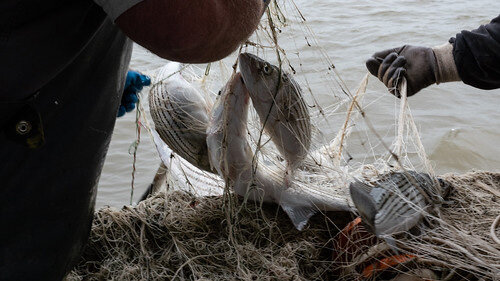Maryland enacts striped bass emergency regulations to increase protections for the spawning population
Striped bass emergency regulations submitted by the Maryland Department of Natural Resources to bolster the species’ spawning population were approved today by the Maryland General …

You must be a member to read this story.
Join our family of readers for as little as $5 per month and support local, unbiased journalism.
Already a member? Log in to continue. Otherwise, follow the link below to join.
Please log in to continue |
Maryland enacts striped bass emergency regulations to increase protections for the spawning population
Striped bass emergency regulations submitted by the Maryland Department of Natural Resources to bolster the species’ spawning population were approved today by the Maryland General Assembly’s Joint Committee on Administrative, Executive, and Legislative Review, and are effective immediately.
The emergency regulations extend periods of closure to recreational striped bass fishing in the Maryland portion of the Chesapeake Bay. Targeting of striped bass will be prohibited from April 1 to May 15, eliminating the Maryland striped bass trophy season. In the Susquehanna Flats, targeting of striped bass is prohibited through the end of May.
The Chesapeake Bay is the primary spawning and nursery area for 70% to 90% of the striped bass of the Atlantic coast. The emergency regulation is aimed at protecting the mature fish that travel up the Bay and return to the rivers where they hatched to spawn each spring.
Emergency regulations can take effect for 180 days; the state is also pursuing these regulation changes through its standard regulatory process which could create regulations that would remain in place beyond 180 days.
These Maryland-specific actions complement additional coast-wide recreational and commercial measures set by the Atlantic States Marine Fisheries Commission (ASMFC). On January 25, ASMFC approved an addendum to the Interstate Fishery Management Plan for Atlantic Striped Bass that aims to reduce fishing mortality in 2024.
For the Chesapeake Bay recreational fishery, which includes charter boat fishing, the addendum implements a 19-inch to 24-inch slot limit and a bag limit of one fish per person, per day. For the ocean recreational fishery, the addendum implements a 28-inch to 31-inch slot limit and a coastwide daily bag limit of one fish. For the commercial fishery, the addendum reduces commercial quotas by 7% in both the ocean and the Bay.
In addition to the approved emergency regulations, Maryland is considering establishing these new rules permanently. The state is also considering extending the recreational and charter boat summer closure by an extra week, through August 7, and closing the commercial hook-and-line season during the recreational and charter boat summer closure. Recreational anglers are currently prohibited from targeting striped bass in all waters of the Chesapeake Bay and its tidal tributaries from July 16 through July 31, the hottest part of summer when fish are most vulnerable to dying after being caught and released.
DNR officials encourage anglers to pursue other fish, such as blue catfish and northern snakehead, instead of striped bass. Blue catfish and snakeheads are invasive species and harvesting them contributes to a healthier ecosystem in the Bay.
The emergency regulations come into effect after five years of below average spawning success for striped bass. In 2023, Maryland’s annual striped bass young-of-year index, which tracks reproductive success, was 1.0, well below the long-term average of 11.1. Environmental conditions, including warm winters and low water flows, have been unfavorable for striped bass spawning and are considered to be factors behind the decreased spawning rates.
The full effects of the diminished spawns will likely become more apparent in the adult population of striped bass in the next few years, as the juveniles reach maturity and contribute to a lower abundance of legal-sized fish. DNR biologists have emphasized the need to protect the spawning stock of striped bass in order to enhance the odds of a successful spawning when environmental conditions are favorable.
A comprehensive striped bass stock assessment scheduled to be released in 2024 will determine how the species has responded to previous management actions made by Maryland and other coastal states during the last few years.
More information on Maryland’s state fish can be found on DNR’s striped bass webpage.






